Radford All SoulsArchaeology
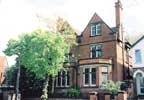 Vicarage Vicarage |
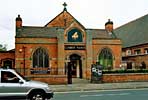 Parish Hall Parish Hall |
The Ordnance Map of 1880 shows that the site at the corner of Ilkeston Road and Lenton Boulevard was open land. To the east of the site (Ilkeston Road) some building development is evident. Land on the south side of the site (Lenton Boulevard) was not used for building until the early part of the 20th century. The Parish Hall was built on the west side of Lenton Boulevard in 1914 opposite the Vicarage, which was next to the church. Both the Vicarage and the Parish Hall are extant, with the former now used as a domestic dwelling and the latter for the display and sale of pianos.
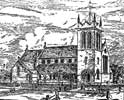 The original design The original design
of the church |
Messrs Naylor and Sale of Derby were commissioned to design the building, producing a church in the decorated style. Their design was however never fully implemented due to lack of funding.
On completion All Souls consisted of a nave, side and central aisles, a sanctuary occupying the area of the planned chancel, the lower part of the planned tower, a north porch, an organ chamber at the east end cut through the south wall, and a vestry. It was planned to complete the building to the original design later so the work that was undertaken was to the architect’s plans: sadly it was never to be.
The original estimate for the building was £6,530 the final cost was £4,600. In 1960 an estimate to complete the chancel was obtained but at £5,320 it once again proved to be unaffordable.
The building contractor was Dennett and Williamson of Nottingham.
The original design was as follows:
| |
Planned dimensions |
Notes |
| Nave |
85' long x 29' wide x 45' high |
It was planned to be much longer. The choir were located in the nave. |
| Chancel |
30' long x 25' wide x 43' high |
|
| Tower |
21' square x 70' high |
Only the lower section about 40 feet tall was built. |
Exterior
Red brick with decorative stone work around the doors and window was used for the exterior. The drip mouldings around the windows appear to be of brick. Stone copings are evident on both gables, each of which has a carved stone cross at its apex. Probably the bricks used were Nottingham Reds; the same bricks can be seen in situ on the Vicarage and Parish Hall and the original boundary walls of both the old and the new church. All the roofs were covered with slate.
Interior
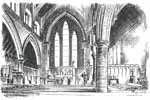 The church interior The church interior |
Three substantial stone round shafts with moulded capitals formed the arcaded nave and supported the clerestory, similar half shafts set against the chancel arch and the west wall completed the arrangement. Four pairs of double trefoil headed windows in the clerestory admitted light. The chancel and choir was formed from the most eastern arch of the nave, with the choir stalls set transversally in the nave in front of the chancel arch, which rose narrow piers projecting from the side walls forming the short sanctuary. Each of the side aisles were used as chapels.
Roofs
The roofs in the side aisle were finished with wood planks over exposed rafters. In the nave vertical wood shafts starting halfway up the clerestory wall between the windows rise to the wall plate with rafters of similar size projecting from them to the apex of the roof, possibly they were overlaid with wood boarding as in side aisles.
Walls
Finished with cement rendering and painted.
Lighting
Incandescing light was installed in 1905, paid for by Mrs. Shepstone. It was replaced by electricity in 1950.
Burials
There is no evidence of burials within the church or churchyard.
The New Church
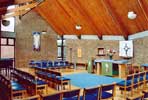 Interior of the Interior of the
new church |
The new All Souls Church is part of the building erected in 1979. It was designed by Architects Peter Smith and T Curtis. Red brick was again used for the exterior and much of the interior. The design was however very different from the old church. It is a seven-sided building with a sharply pointed grey tiled roof. The church has an office on the ground floor with the church above on the first floor. Access is by two stage staircase complete with an electric stair lift. The furnishing is modern with chairs instead of pews and full height windows admitting natural light. Truly a church of the 20th century.
|